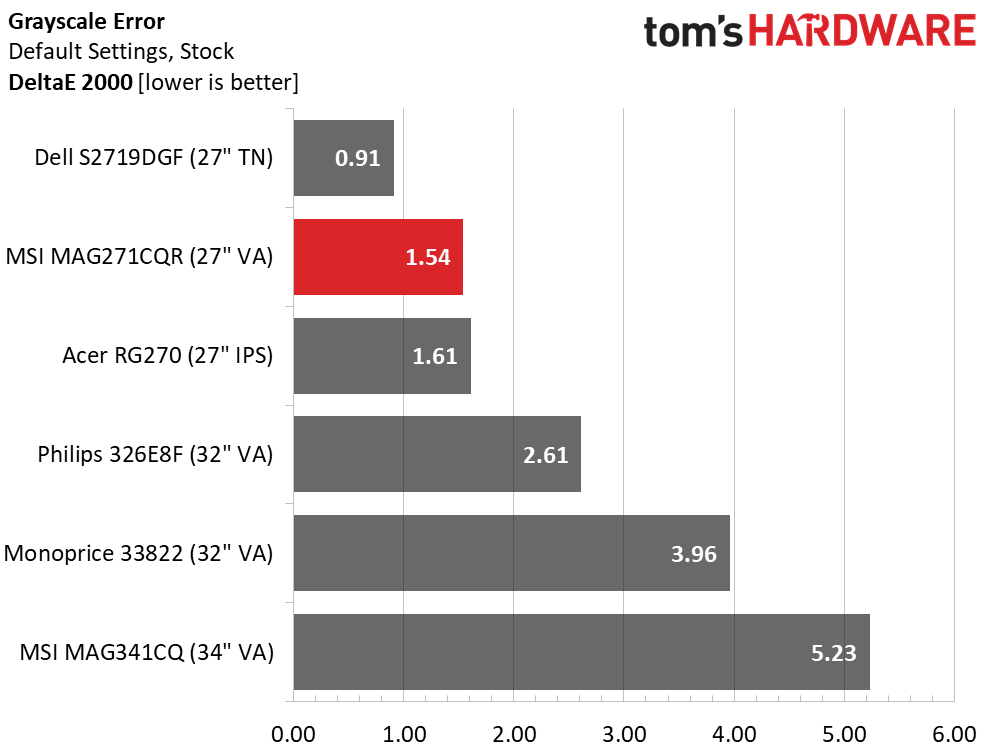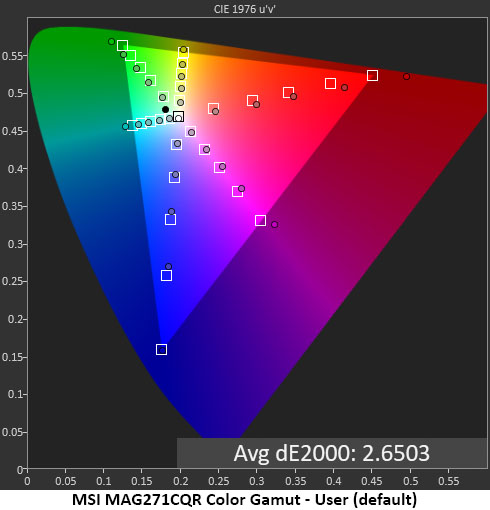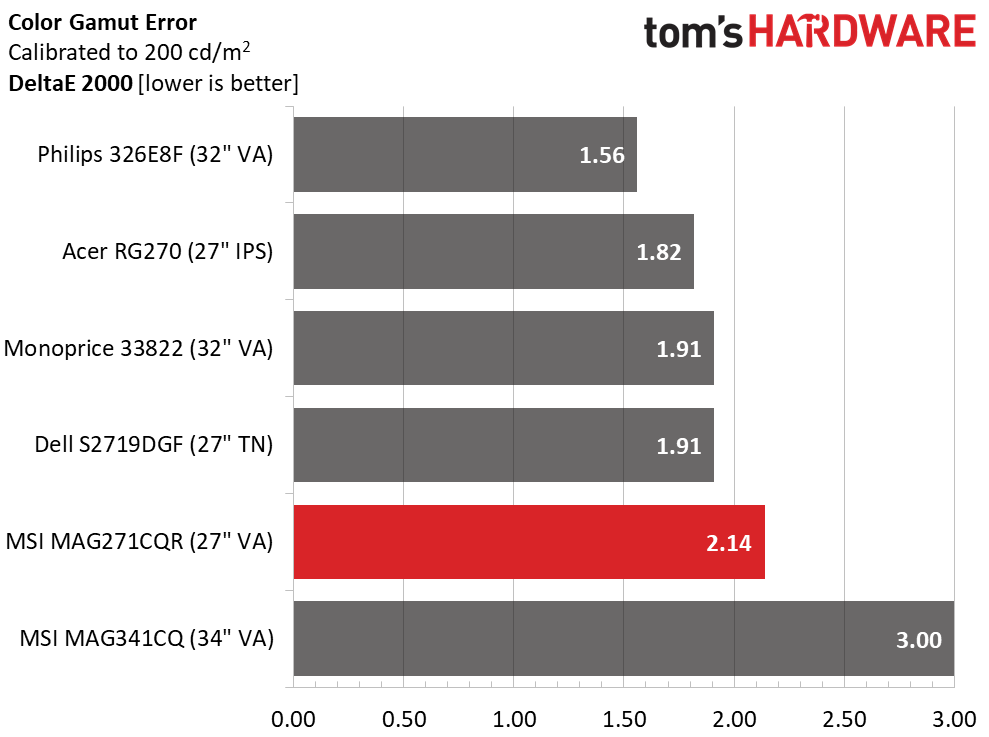MSI Optix MAG271CQR Gaming Monitor Review: Vivid and Versatile
Why you can trust Tom's Hardware
Grayscale, Gamma and Color
After trying several different settings combinations, we concluded that the MAG271CQR is best left uncalibrated. Working the RGB sliders improved grayscale accuracy slightly but created gamma issues we couldn’t ignore. The charts below help explain our observations.
Grayscale & Gamma Tracking
We describe grayscale and gamma tests in detail here.



Credit: Tom’s Hardware
The out-of-box measurement (first chart) shows good tracking with no visible errors at any brightness level. Our only concern is the gamma trace, which is mostly too light except for a slight darkness at the 10% step. We prefer to see the white trace at or slightly above the yellow reference line. VA monitors with their extra contrast often look better at gamma values of 2.25 or 2.3. The MAG271CQR is too light at an average of just 2.0197. It would be great if MSI provided a few gamma options.
Calibration of the RGB sliders (second chart) improved grayscale tracking a little but took gamma well off the mark. The 10% brightness level became virtually indistinguishable from the 0% one. This means deep shadow details were lost, hurting picture quality. Additionally, max brightness is much lower at just 150 nits.
By going with the Normal color temp preset and just lowering the brightness slider to 43 (third chart), we achieved decent grayscale tracking with just the tiniest errors (blue tint) at 90 and 100% brightness. Gamma could be better, but at least shadow detail was restored. This is the best possible compromise between light output, contrast and color accuracy.
Comparisons




Out of the box, the MAG271CQR has no visible errors with a very low Delta E (de) average of 1.54. Usually, turning down the backlight doesn’t affect this score, but when we decreased brightness to 200 nits, the average error increased slightly to 2.63dE. There are slightly visible tints at 90 and 100% brightness, but they’re hard to see in actual content. However, this still means a last place finish for the MSI. The problem isn’t huge, but the other screens fared better.
Get Tom's Hardware's best news and in-depth reviews, straight to your inbox.
Our chief gripe with the MAG271CQR’s gamma is its low average value. At 200 nits, a 0.48 range of numbers isn’t terrible, so the luminance curve is at least consistent. But we’d like to see an average of at least 2.2. VA monitors look their best when the gamma is correct or even a bit above 2.2. This is an area we hope MSI will address with a firmware update.
Color Gamut Accuracy
MSI takes a unique approach to color reproduction. We’ve seen similar traits from all the MSI screens we’ve tested. Rather than adhering strictly to sRGB or DCI, it uses a gamut we’ve dubbed sRGB+. You get extra color saturation in brighter content but in the lower and mid-range tones, the monitors stick to the spec. Check out the charts to see what we mean.
For details on our color gamut testing and volume calculations, click here.



When measured against the sRGB standard, the MAG271CQR hits all its saturation targets up to 60%. At 80 and 100% (the two outermost boxes), color is extended almost to the full DCI-P3 gamut. This creates an image that is very colorful when content is bright, but more accurate and natural in the low and mid-range hues. We like the effect even though it doesn’t stick to the letter of the color law. If you’re looking for an extra colorful monitor, MSI is a good choice.
Turning the backlight down to 200 nits had no effect on gamut accuracy. The difference is just 0.511dE, which can’t be seen by the naked eye. In both cases, the only colors that are off-target are red and green at 80 and 100% and magenta at 100%. The rest of the gamut is pretty much on the money.
MSI markets the MAG271CQR as supporting DCI-P3, so we measured against that standard too. It hit the red and blue 100% targets but falls a bit short in green, so the monitor can be said to deliver most of the P3 gamut. The inner targets are fairly under-saturated. Ultimately, displaying DCI-mastered content on this monitor wouldn’t be ideal, as the image would look a little washed out unless it was very bright. This is best considered an sRGB monitor with extra saturation in the brightest tones.
Comparisons


Given all the tweaking MSI has done to the color gamut, you might think the color gamut error would be high, but it’s not. By hitting all the inner targets, there are only a few areas at the perimeter of the gamut that are off. This is a good approach to providing extra color without straying too far from the realm of accuracy. While we’d prefer all measurements to be on target, the MAG271CQR delivers an excellent picture that will satisfy most users.
With those extended primaries, sRGB volume is just over 120%, and DCI-P3 manages to crack the 80% barrier. The MAG271CQR is not suitable for color-critical tasks without a custom profile in place. But it looks great when gaming or watching video content.
MORE: Best Gaming Monitors
MORE: How We Test Monitors
MORE: All Monitor Content
Current page: Grayscale, Gamma and Color
Prev Page Brightness and Contrast Next Page Viewing Angles, Uniformity, Response and Lag
Christian Eberle is a Contributing Editor for Tom's Hardware US. He's a veteran reviewer of A/V equipment, specializing in monitors. Christian began his obsession with tech when he built his first PC in 1991, a 286 running DOS 3.0 at a blazing 12MHz. In 2006, he undertook training from the Imaging Science Foundation in video calibration and testing and thus started a passion for precise imaging that persists to this day. He is also a professional musician with a degree from the New England Conservatory as a classical bassoonist which he used to good effect as a performer with the West Point Army Band from 1987 to 2013. He enjoys watching movies and listening to high-end audio in his custom-built home theater and can be seen riding trails near his home on a race-ready ICE VTX recumbent trike. Christian enjoys the endless summer in Florida where he lives with his wife and Chihuahua and plays with orchestras around the state.